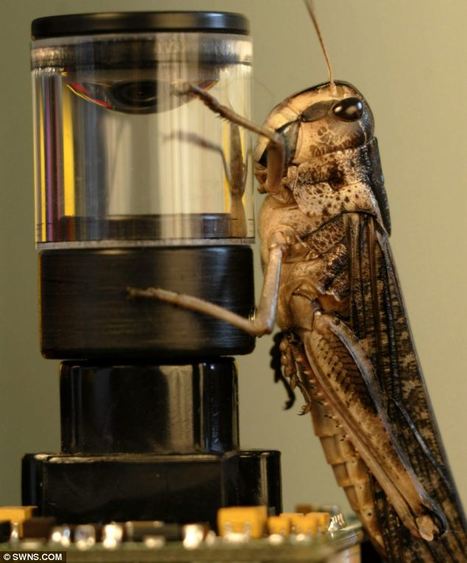Une équipe internationale de chercheurs travaillent actuellement sur un système anti-collision pour les véhicules, basées sur les caractéristiques de la vision du criquet.
Et si le criquet permettait d'empêcher les accidents de voiture et par là même de sauver des milliers de vie chaque année ? Si l'idée peut étonner, c'est précisément ce qu'affirment des chercheurs de l’université anglaise de Lincoln, en collaboration avec celle d’Hambourg, en Allemagne et de Tsinghua à Pékin, en Chine. En effet, ceux-ci se sont inspirés de l’appareil visuel de l'insecte, pour mettre au point une technologie anti-collision pour voitures.
Comme beaucoup d’insectes, le criquet est doté d’un système d’alerte anticipé qui lui permet d’éviter les heurts lors de voyages à grande vitesse au cœur d’un essaim. Les scientifiques ont ainsi cherché à mettre en évidence les caractéristiques de cette fonction d’alarme afin de mettre en place un modèle de capteurs. Au final, l’équipe est parvenue à identifier un ensemble de signaux électriques et chimiques transmis au cerveau et à les retranscrire dans un système informatique.
Le dispositif innovateur, n’a rien en commun avec les radars ou détecteurs infrarouges actuels. Récemment installé sur un robot, il permet d’explorer différents chemins et d’interagir avec les objets rencontrés en les identifiant préalablement et en les évitant. "La vision joue un rôle essentiel dans l'interaction pour la plupart des espèces animales et possède de remarquables capacités de traitement de l'image" explique au Dailymail Shigang Yue de l’Université de Lincoln.
Contrer les erreurs humaines
Il poursuit : "Par exemple, les insectes peuvent répondre à l'approche de prédateurs à une vitesse remarquable". Cette recherche représente un véritable pas en avant dans la modélisation informatique de systèmes biologiques tels que la vision et d'autres fonctions sensorielles. Les chercheurs espèrent que le dispositif pourra être sous peu utilisé dans l’industrie automobile. "Il pourrait permettre aux véhicules de comprendre ce qui se passe sur la route et prendre des mesures plus rapides", indique encore le chercheur.
"Ces travaux offrent des indications importantes sur la façon dont nous pouvons développer un système pour la voiture, ce qui pourrait améliorer les performances à un niveau tel que l'on pourrait contrer l'erreur humaine".
-------
NDÉ
Pour en savoir plus (en anglais)
→ How locusts could save countless lives: Scientists adopt the insects' early warning system to create collision sensors for cars | Daily Mail Online, 04.03.2013 https://www.dailymail.co.uk/sciencetech/article-2287816/How-locusts-save-countless-lives-Scientists-adopt-insects-early-warning-create-collision-sensors-cars.html
How 'locust vision' could stop car crashes: Scientists reveal collision sensors based on the insect's early warning system
-
Scientists have created a new technology that could prevent car crashes
-
It is inspired by locusts' system that allows them to fly fast in swarms
By Emma Innes
Published: 12:54 GMT, 4 March 2013 | Updated: 13:22 GMT, 4 March 2013
Scientists have created a revolutionary technology that could save countless lives by preventing car crashes, and it is inspired by locusts.
The insects have an early warning system which helps them avoid colliding with each other when flying in swarms at high speed.
Researchers have adopted key features of the locusts’ system to develop a computer system which could become a blueprint for highly-accurate collision sensors in cars.
Scientists at the University of Lincoln created a collision sensor for cars (pictured) after being inspired by locusts' anti-collision systems
Professor Shigang Yue and Dr Claire Rind of the University of Lincoln were inspired by the unique way locusts process electrical and chemical signals in their brain.
Professor Yue said: ‘We created a system inspired by the locusts' motion sensitive interneuron - the lobula giant movement detector.
‘It was used in a robot to enable it to explore paths or interact with objects, effectively using visual input only.
‘Vision plays a critical role in the interaction of most animal species and even relatively low-order animals have remarkable visual processing capabilities.
‘For example, insects can respond to approaching predators with remarkable speed.
Scientists were inspired to create the sensor (pictured) by the unique way locusts process electrical and chemical signals in their brain
‘This research demonstrates that modelling biologically plausible, artificial visual neural systems can provide new solutions for computer vision in dynamic environments.
‘It could be used to enable vehicles to understand what is happening on the road ahead and take swifter action.’
Dr Rind added: ‘Developing robot neural network programmes, based on the locust brain, has allowed us to create a programme allowing a mobile robot to detect approaching objects and avoid them.
HOW DOES THE NEW SYSTEM WORK?
The scientists created a computer system inspired by the locusts' motion sensitive interneuron - the lobula giant movement detector.
The research showed that modelling biologically plausible, artificial visual neural systems can provide new solutions for computer vision in dynamic environments.
It was tested in a robot to allow it to explore paths and interact with objects - it is different to previous technology as it avoids using radar or infrared detectors.
It could now be applied to vehicles to allow them to understand what is happening on the road ahead.
‘It's not the conventional approach as it avoids using a radar or infrared detectors, which require very heavy-duty computer processing.
‘Instead, it is modelled on the locust's eyes and neurones as the basis of a collision avoidance system.
‘We want to apply this work to collision avoidance systems in vehicles, a major challenge for the automotive industry.
‘This research offers us important insights into how we can develop a system for the car which could improve performance to such a level that we could take out the element of human error.’
The research was carried out as part of a collaborative project with the University of Hamburg and China's Tsinhua University and Xi'an Jiaotong University.The system is modelled on the locust's eyes and neurones



 Your new post is loading...
Your new post is loading...







